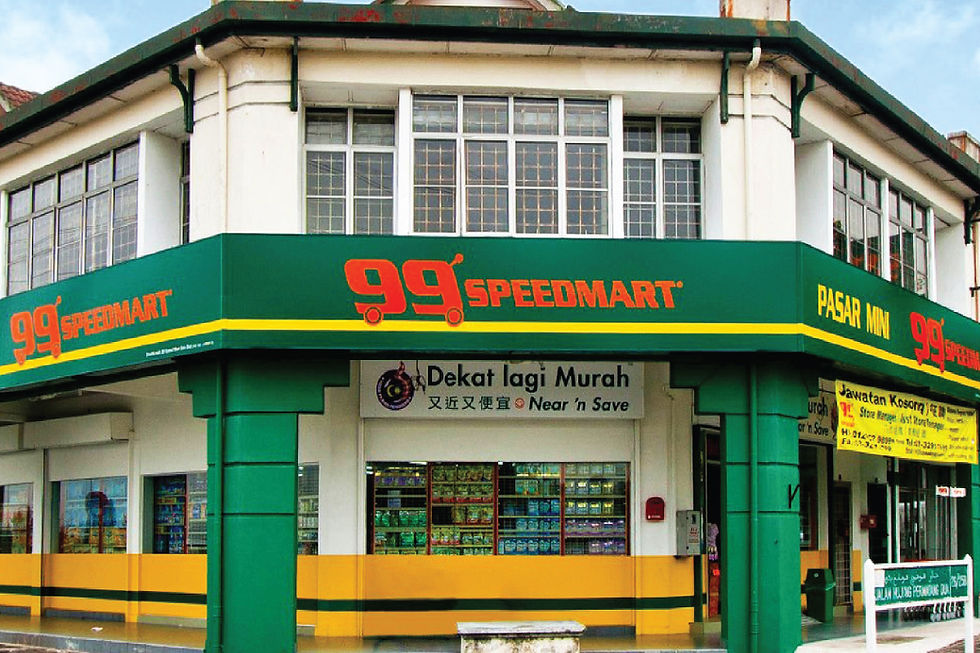99 Speedmart’s IPO: What You Need to Know Before Buying Their Shares
- Catherine Ooi
- Sep 4, 2024
- 6 min read
On September 9, 2024, 99 Speedmart is set to make a significant move in Malaysia’s retail market with its Initial Public Offering (IPO). The company plans to raise RM2.36 billion, making it the largest IPO in Malaysia since 2017. With over 2,600 outlets serving 1.1 million customers daily, 99 Speedmart is a retail powerhouse.
In conjunction with this news, this article shall break down the key details of the 99 Speedmart IPO, including its:
1. Brief Backstory
2. Their Business Model
3. Important IPO Related Numbers
4. Financial Metrics and Market Valuation
5. Growth Plans from IPO Proceeds
6. Benefit for Malaysia’s Economy
7. Challenges Post-IPO
Want to Learn More About IPOs?
Need a quick overview of IPOs and how they can impact your portfolio?
Check out our article: What You Need to Know About Investing in IPOs or F.A.Q Show's An IPO Walkthru video that can provide deeper insights into the IPO process, potential benefits, and risks, helping you make informed decisions when considering investments like 99 Speedmart.
The Story Behind 99 Speedmart’s Success

How did 99 Speedmart reach this monumental milestone?
The journey began with its founder, Lee Thiam Wah. After contracting polio at 8 months old, Lee was left with a physical disability, facing significant challenges growing up. However, his determination and entrepreneurial spirit led him to create Malaysia’s largest mini-market chain.
Driven by his belief in hard work and community service, Lee expanded that small grocery into what is today known as 99 Speedmart, Malaysia’s largest chain of mini-markets. Over the years, the company has grown to operate more than 2,600 outlets nationwide, catering to millions of customers.
99 Speedmart’s success is built on three core values: affordability, accessibility, and excellent customer service. These values continue to guide the company’s operations today, making it a trusted name in Malaysia’s retail landscape.
What’s Their Business Model?
99 Speedmart operates in the retail industry, specifically as a chain of mini-markets. They cater to the daily needs of consumers by providing a wide range of grocery and household products, emphasising convenience and affordability.
This is where their business model is centred around high-volume, low-cost retailing. By offering essential products at competitive prices, 99 Speedmart can attract a broad customer base, including those who are budget-conscious.
The company has strategically leveraged economies of scale to maintain its market dominance. Through an extensive network of distribution centres and advanced logistics systems, 99 Speedmart ensures affordability and efficiency in its supply chain.
Important IPO Numbers

What makes the 99 Speedmart IPO so significant? Here are the key numbers:
• RM2.36 Billion: The amount 99 Speedmart aims to raise, signalling ambitious expansion plans.
• RM1.65 per Share: The price for each of the 400 million new shares, designed to appeal to a wide range of investors, including retail and institutional investors.
• RM13.9 Billion: Expected market capitalisation post-IPO, placing 99 Speedmart among Malaysia’s retail leaders.
• 55% Investor Backing: The IPO has strong support from government-linked companies and major asset managers, a positive signal of confidence from established investors.
99 Speedmart’s Market Valuation Aligns with Top Brands - Nestlé and MR DIY
In FY2023, 99 Speedmart reported a net profit of RM400.2 million (4.76 sen per share), giving it a Price-Earnings Ratio (PER) of 34.7 times. The company’s profit has grown at a Compound Annual Growth Rate (CAGR) of 13.3% over the past three years, resulting in a Price-Earnings Growth (PEG) ratio of 2.6 times. This valuation aligns 99 Speedmart with top Malaysian consumer stocks like Nestlé and MR DIY.
Therefore, it doesn't just signals that 99 Speedmart is not just profitable, but also shows strong potential for sustained growth. This growth trajectory is one of the key reasons why the 99 Speedmart IPO has attracted so much attention.
Solid Financial Footing
Another reason for investor interest is because, as of March 2024, 99 Speedmart had a net cash position of RM27.8 million, with RM78.5 million in cash against RM50.7 million in borrowings. This solid financial footing allows the company to manage debt efficiently and reinvest in growth, making the 99 Speedmart IPO even more attractive.
The ability to manage debt and still have capital for growth is a major factor that makes the 99 Speedmart IPO an attractive proposition.
The company’s solid balance sheet reduces risk for investors, making it a safer investment option compared to companies with higher debt loads.
Big Investors on Board
Post-IPO, Lee Thiam Wah and his wife will retain an 83% stake in 99 Speedmart, leaving 17% for public trading. Among this, 14 cornerstone investors, including AHAM Asset Management, AIA, EPF, and Perkeso, will hold 9.35% of the company.
Additionally, a moratorium will be placed on the shares held by Lee and his wife, restricting their sale for a specific period. This ensures ownership stability and reassures investors about the company’s long-term growth prospects.
Oversubscribed IPO by 3.04 Times

99 Speedmart isn’t just another retailer—it’s a leader in Malaysia’s mini-mart industry, holding a 40.1% market share as of 2023. The RM2.36 billion raised from this IPO is set to fuel further growth with expansion and infrastructure upgrades.
The strong market interest in 99 Speedmart’s IPO is evident as the IPO was oversubscribed by an impressive 3.04 times, reflecting high investor confidence in the company’s potential.
However, it also means competition for shares will be fierce, possibly driving up the share price once the stock is listed.
Growth Plans for 99 Speedmart

How will 99 Speedmart use their IPO proceeds to grow the business further? Here are the notable plans:
• Aggressive Store Expansion: RM389 million to open 250 new outlets annually until 2025, increasing the total to 3,000 stores. This expansion will enhance the company’s accessibility and market presence.
• Strengthening Supply Chain: RM100 million will be allocated to building new distribution centres to support the expanding network. These facilities will support the expanding store network and help maintain product availability.
• Upgrading Existing Stores: RM47.6 million to modernise existing outlets and enhance customer experience. This will improve the customer experience and help maintain loyalty in a competitive retail landscape.
• Debt Reduction: RM45 million to lower debt and strengthen financial stability as they will allocate approximately 6.8% of the gross proceeds. It helps to repay 14 term loan facilities with Alliance Bank Berhad, while pursuing more aggressive growth plans in the Malaysian retail market scene.
How the 99 Speedmart IPO Benefits Malaysia
The 99 Speedmart IPO is not just a financial event to raise funds; it holds broader significance for Malaysia’s economy:
• Boosting Investor Confidence: A successful IPO could attract further investments in Malaysia’s retail sector. When a major player like 99 Speedmart performs well, it often attracts more investments, leading to innovation and competition.
• Creating Jobs: Expansion will create jobs, particularly in less developed areas, helping lift more people out of unemployment and stimulate local economies, further boosting consumer spending.
• Improving Supply Chains: With new distribution centres on the horizon, 99 Speedmart could set new benchmarks for supply chain efficiency in Malaysia’s retail industry. More efficient supply chains can lead to better product availability and potentially lower prices for consumers.
• Supporting Local Brands: With more stores and increased purchasing power, 99 Speedmart can give local products more shelf space, helping smaller Malaysian brands reach a wider audience. This support could lead to higher sales for local manufacturers and suppliers, providing them with the stability needed to grow.
Challenges Post-IPO
While the prospects for 99 Speedmart are promising, few challenges could impact the company’s profitability:
Intense Competition: The retail sector in Malaysia is highly competitive. If 99 Speedmart cannot maintain its pricing or convenience advantage, it risks losing market share to larger players like supermarkets and hypermarkets.
Supply Chain Disruptions: Like all retailers, 99 Speedmart is vulnerable to supply chain issues. Disruptions, whether due to global events or logistical challenges, could lead to stock shortages and increased costs.
Labour-Intensive Operations: 99 Speedmart relies heavily on human labour. Delays in automation or rising labour costs could impact the company’s profit margins and growth potential.
Final Thoughts
The 99 Speedmart IPO represents a significant milestone in Malaysia’s retail sector. With strong financial backing, ambitious growth plans, and a solid market position, the company is well-poised for future success. However, as with any investment, it's essential to consider the risks, including market competition, supply chain disruptions, and reliance on labour.
As the IPO date approaches, we encourage you to do your own research (DYOR) to assess how the 99 Speedmart IPO fits into your financial strategy. The decision should align with your investment goals and risk tolerance.
Disclaimer: The information provided in this article is for educational and informational purposes only and should not be construed as financial or investment advice. Please consult with a qualified financial advisor or do your own research before making any investment decisions.
Subscribe to our financial newsletter for the latest news, insights, and advice on personal finance, investing, and more. With every email, you’ll gather the confidence and knowledge to make informed decisions to achieve your financial goals.
Reference Links:
99 Speed Mart IPO to raise RM2.3b, largest IPO in seven years
99 Speedmart IPO likely priced around RM1.20 to RM1.50 per share
99 Speed Mart files for IPO, seeking minimum public shareholding spread of 15%
99 Speed Mart mulling IPO at up to RM1.5 bil value, say sources
99 Speed Mart's IPO, Malaysia's largest in 7 years, oversubscribed 3.04 times | The Star
